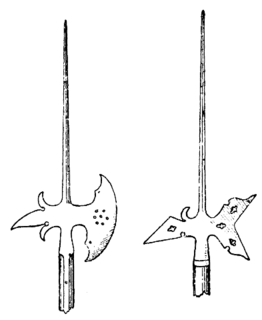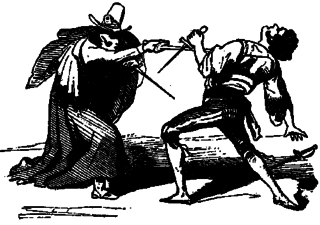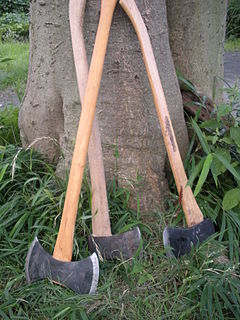Related Research Articles

Fencing is a group of three related combat sports. The three disciplines in modern fencing are the foil, the épée, and the sabre ; winning points are made through the weapon's contact with an opponent. A fourth discipline, singlestick, appeared in the 1904 Olympics but was dropped after that, and is not a part of modern fencing. Fencing was one of the first sports to be played in the Olympics. Based on the traditional skills of swordsmanship, the modern sport arose at the end of the 19th century, with the Italian school having modified the historical European martial art of classical fencing, and the French school later refining the Italian system. There are three forms of modern fencing, each of which uses a different kind of weapon and has different rules; thus the sport itself is divided into three competitive scenes: foil, épée, and sabre. Most competitive fencers choose to specialize in one weapon only.
A machete is a broad blade used either as an agricultural implement similar to an axe, or in combat like a long-bladed knife. The blade is typically 30 to 45 centimetres long and usually under 3 millimetres (0.12 in) thick. In the Spanish language, the word is a diminutive form of the word macho, which was used to refer to sledgehammers. In the English language, an equivalent term is matchet, though it is less commonly used. In the English-speaking Caribbean, such as Jamaica, Barbados, Guyana, and Grenada and in Trinidad and Tobago, the term cutlass is used for these agricultural tools.

A pole weapon or pole arm is a close combat weapon in which the main fighting part of the weapon is fitted to the end of a long shaft, typically of wood, thereby extending the user's effective range and striking power. Because many pole weapons were adapted from agricultural implements or other tools in fairly large amount of abundance, and contain relatively little metal, they were cheap to make and readily available. When warfare breaks out and the belligerents have a poorer class who cannot pay for dedicated weapons made for war, military leaders often resort to the appropriation of tools as cheap weapons. The cost of training was minimal, since these conscripted farmers had spent most of their lives in the familiar use of these "weapons" in the fields. This made polearms the favored weapon of peasant levies and peasant rebellions the world over.
A sword is a bladed melee weapon intended for cutting or thrusting that is longer than a knife or dagger, consisting of a long blade attached to a hilt. The precise definition of the term varies with the historical epoch or the geographic region under consideration. The blade can be straight or curved. Thrusting swords have a pointed tip on the blade, and tend to be straighter; slashing swords have a sharpened cutting edge on one or both sides of the blade, and are more likely to be curved. Many swords are designed for both thrusting and slashing.

A halberd is a two-handed pole weapon that came to prominent use during the 14th, 15th, and 16th centuries. The word halberd is most likely equivalent to the German word Hellebarde, deriving from Middle High German halm (handle) and barte (battleaxe) joint to helmbarte. Troops that used the weapon are called halberdiers.

A shuriken is a Japanese concealed weapon that was used as a hidden dagger or metsubushi to distract or misdirect.

The kukri or khukuri is a type of machete, originating from the Indian subcontinent, associated with the Nepali speaking Gurkhas of Nepal and India. The knife has a distinct recurve in the blade. It is used as both a tool and as a weapon in the Indian subcontinent. Traditionally, it was, and in many cases still is, the basic utility knife of the Gurkha. It is a characteristic weapon of the Nepalese Army, the Royal Gurkha Rifles of the British Army, the Assam Rifles, the Kumaon Regiment, the Garhwal Rifles, the Gorkha regiments of the Indian Army, and of all Gurkha regiments throughout the world, so much so that some English-speakers refer to the weapon as a "Gurkha blade" or "Gurkha knife". The kukri often appears in Nepalese and Indian Gorkha heraldry and is used in many traditional rites such as wedding ceremonies.

Dao are single-edged Chinese swords, primarily used for slashing and chopping. The most common form is also known as the Chinese sabre, although those with wider blades are sometimes referred to as Chinese broadswords. In China, the dao is considered one of the four traditional weapons, along with the gun, qiang (spear), and the jian, and among them is called "The Marshal of Weapons".

The katar or katara is a type of push dagger from the Indian subcontinent. The weapon is characterized by its H-shaped horizontal hand grip which results in the blade sitting above the user's knuckles. Unique to the Indian subcontinent, it is the most famous and characteristic of Indian daggers. Ceremonial katars were also used in worship.

A foil is one of the three weapons used in the sport of fencing, all of which are metal. It is flexible, rectangular in cross section, and weighs under a pound. As with the épée, points are only scored by contact with the tip, which, in electrically scored tournaments, is capped with a spring-loaded button to signal a touch. A foil fencer's uniform features the lamé. The foil is the most commonly used weapon in competition.
The karambit, kerambit, kurambik, karambol or karambiak is a small Indonesian curved knife resembling a claw.

A switchblade is a type of knife with a folding or sliding blade contained in the handle which is extended automatically by a spring when a button, lever or switch on the handle or bolster is activated. Most switchblade designs incorporate a locking blade, in which the blade is locked against closure when the spring extends the blade to the fully opened position. The blade is unlocked by manually operating a mechanism that unlocks the blade and allows it to be folded and locked in the closed position.

The épée is the largest and heaviest of the three weapons used in the sport of fencing. The modern épée derives from the 19th-century Épée de Combat, a weapon which itself derives from the French small sword.

A balisong, also known as a fan knife, butterfly knife or Batangas knife, is a folding pocketknife from the Philippines. Its distinct features are two handles counter-rotating around the tang such that, when closed, the blade is concealed within grooves in the handles. A balisong typically has the latch on the handle facing the cutting edge, and is commonly called the bite handle.

A kunai is a Japanese tool thought to be originally derived from the masonry trowel. The two widely recognized variations of the kunai are short kunai and the big kunai. Although a basic tool, in the hands of a martial arts expert, the kunai could be used as a multi-functional weapon. The kunai is commonly associated with the ninja, who used it to gouge holes in walls. Many popular manga characters use kunai as both their primary and secondary weapons.

The English language terminology used in the classification of swords is imprecise and has varied widely over time. There is no historical dictionary for the universal names, classification or terminology of swords; A sword was simply a double edged knife.

The parrying dagger is a category of small handheld weapons from the European late Middle Ages and early Renaissance. These weapons were used as off-hand weapons in conjunction with a single-handed sword such as a rapier. As the name implies they were designed to parry, or defend, more effectively than a simple dagger form, typically incorporating a wider guard, and often some other defensive features to better protect the hand as well. They may also be used for attack if an opportunity arises. The general category includes two more specific types, the sword breaker and trident dagger.
A katana is a Japanese sword characterized by a curved, single-edged blade with a circular or squared guard and long grip to accommodate two hands. It was used by the samurai of ancient and feudal Japan.

An axe is an implement that has been used for millennia to shape, split and cut wood, to harvest timber, as a weapon, and as a ceremonial or heraldic symbol. The axe has many forms and specialised uses but generally consists of an axe head with a handle, or helve.
References
- ↑ "Chopper (vechevoral, cha katti)". Royal Armouries.
- ↑ Weapon: A Visual History of Arms and Armour. Dorling Kindersley. 2006. pp. 190–191. ISBN 0-7566-2210-7.
| This article related to weaponry is a stub. You can help Wikipedia by expanding it. |